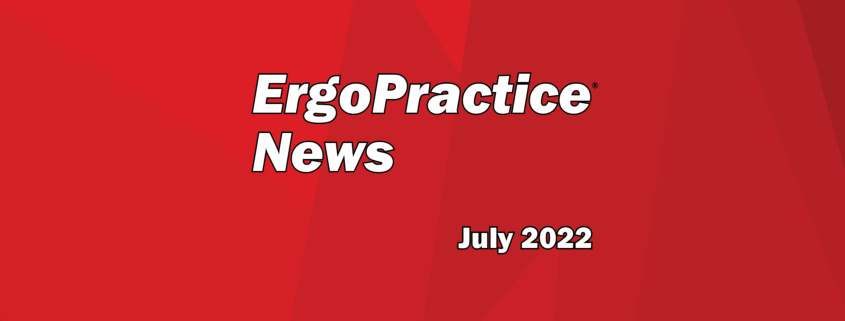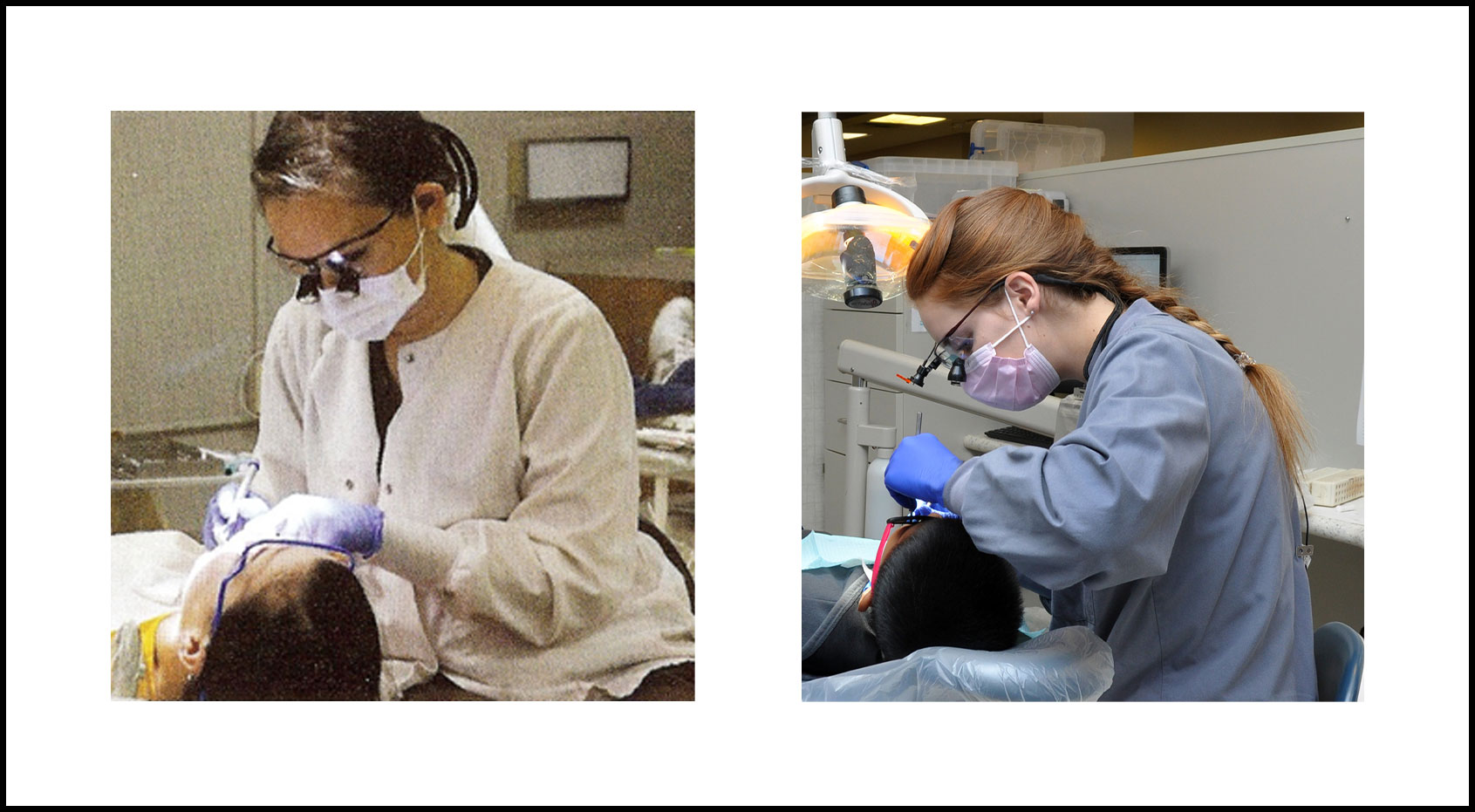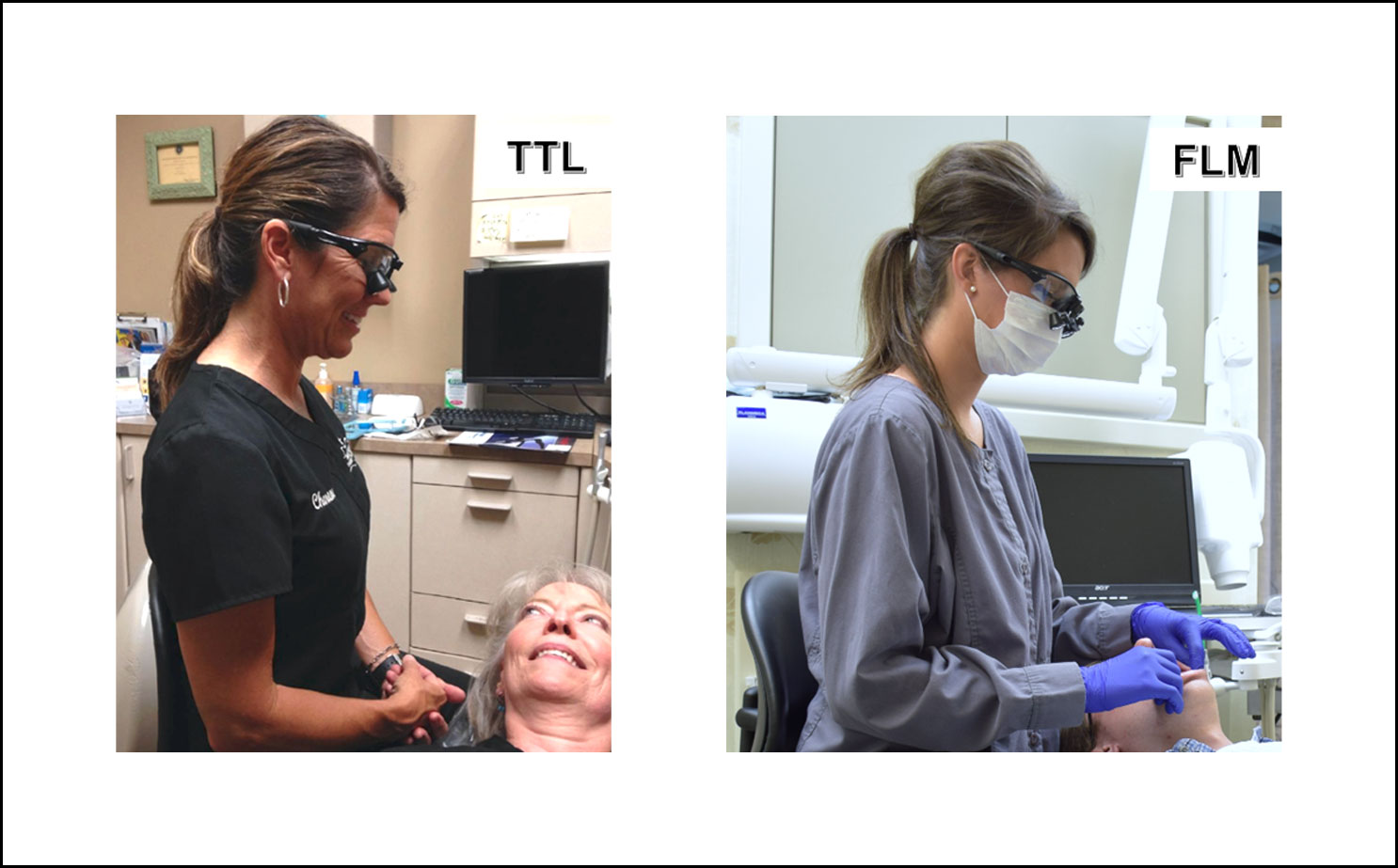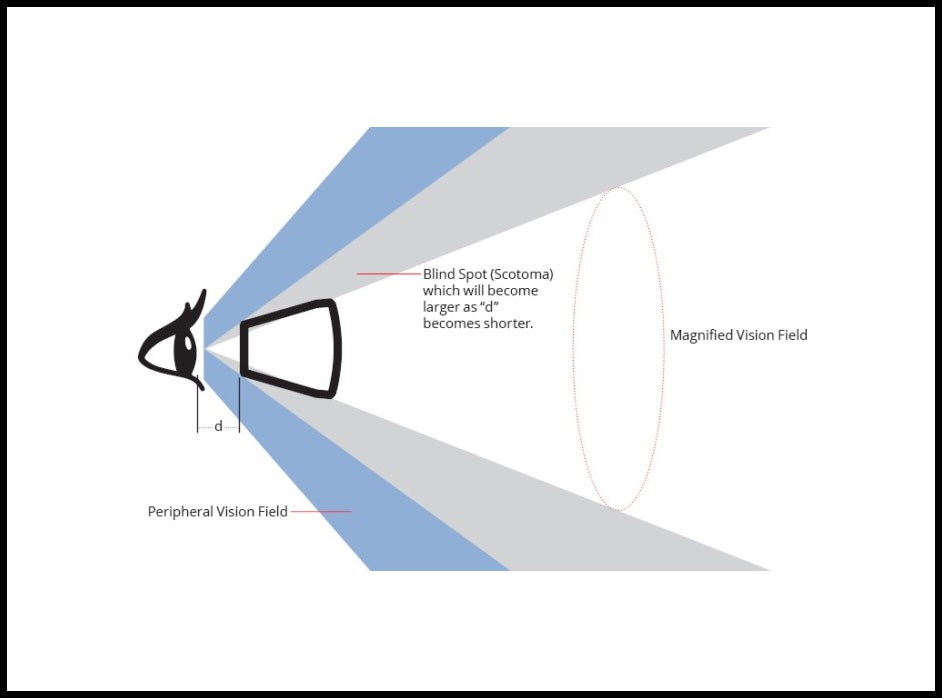Roles of SurgiTel’s Front-Lens-Mounted (FLM) Loupes for a Pain-Free Practice

ErgoPractice News – July 2022
By Jin Chang PhD
jchang@surgitel.com
Summary
SurgiTel’s Front-Lens-Mounted (FLM) loupes are the only customizable loupes with a full range of magnification powers, allowing customers to create a custom declination angle for their maximum neck comfort.1 In this issue, we will review the important roles that SurgiTel’s customizable FLM loupes has in creating a pain-free practice based on input from customers. Before we review various roles of SurgiTel’s customizable FLM loupes, let’s look at the brief history of loupes in dentistry and why so many clinicians today have been experiencing chronic neck pain even though they may believe they have been using ergonomic loupes.
Brief History of Loupes in Dentistry and Chronic Neck Pain
In the early 1980s, Orascoptic introduced FLM loupes to dental professionals. But the declination angle of these FLM loupes was small and did not help users maintain their heads within the safe head tilt range.2
In 1992, SurgiTel introduced the world’s first ergonomic FLM loupes which allow dental professionals to create their own optimum declination angles for maximum neck comfort. Many dental schools at the time recommended SurgiTel’s ergonomic FLM loupes to their students for the ergonomic benefits it offers.3,4
In the late 1990s, Orascoptic introduced Through-The-Lens (TTL) loupes as advanced loupes, even though they had small declination angles, which were similar to TTL loupes made by Designs for Vision. As a result of Orascoptic’s successful marketing of TTL loupes as a new advanced technology, these non-ergonomic TTL loupes were well accepted by many students. It is noted that TTL loupes were originally developed to help those with low vision to read small print. In the early 1940s, surgeons started to use loupes for their surgical procedures because they found that loupes were helpful to see the fine anatomical features of their operating sites.
Since these non-ergonomic TTL loupes support the natural human behavior of tilting the head to see details, and serious chronic pain will not develop until many years later, these non-ergonomic TTL loupes became very popular among students. The use of non-ergonomic TTL loupes has become the main cause of chronic neck pain today. Figure 1 shows working postures while wearing non-ergonomic loupes. To eliminate ergonomic issues related to TTL loupes, SurgiTel started to develop ergonomic TTL loupes.
In the late 1990s, SurgiTel invented the Ergo frames (with a large pantoscopic tilt) for TTL loupes to offer larger declination angles. However, the increased declination angle with Ergo frames was not large enough for some clinicians who have a high nose. So, SurgiTel invented the Ergo Max frames and new assembly technology to provide truly ergonomic loupes for all clinicians. Figure 2 shows Ergo frames and Ergo Max frames which can have different lenses for different facial features.
With advanced frame and assembly technology, SurgiTel can offer truly ergonomic TTL loupes with any declination angle for maximum neck comfort. Today, SurgiTel ergonomic TTL loupes have been accepted as a solution to alleviate chronic neck pain that is developed with the use of non-ergonomic TTL loupes. Figure 3 shows postures when using SurgiTel ergonomic loupes.
In the late 2010s, LumaDent introduced deflection loupes (called ErgoPrism) which are similar to deflection loupes made by Pentax in Japan. Pentax introduced their deflection loupes in Japan and Asian markets about 15 years ago.5 However, they have not been widely accepted by Japanese and Asian dental professionals because SurgiTel ergonomic FLM and TTL loupes were already well accepted by Japanese and Asian dental professionals. The deflection angle of the Pentax deflection loupes was too steep and too difficult to use for the various procedures.
In 2021, SurgiTel invented a new deflection prism and designed a new generation of deflection loupes, called ErgoDeflection™ loupes. ErgoDeflection loupes will be introduced in September or October 2022.
Roles of SurgiTel’s FLM Loupes for a Pain-Free Practice
The first role of customizable FLM loupes is to help students find their optimum declination angle of loupes that supports a safe neck posture with a head tilt angle of less than 20-degrees.6 If they want TTL loupes in the future, they can purchase TTL loupes at their optimum declination angle. If students purchase TTL loupes with improper declination angles, they can develop bad working posture habits which creates chronic neck pain. The development of chronic neck pain due to the use of non-ergonomic loupes may take many years. By the time you feel chronic pain, the neck muscles may already be significantly damaged. Although today most schools let students choose their first loupes, some dental and hygiene schools still recommend customizable FLM loupes to their students. It is noted that clinical ergonomics experts such as Dr. Bethany Valachi and Dr. Lance Rucker recommend customizable FLM loupes to dental professionals as the first pair of loupes.6,7
The second role is to help clinicians slowly improve their bad posture developed from using non-ergonomic loupes. Clinicians who used non-ergonomic loupes for an extended period may not be able to easily change their poor working postures formed from using non-ergonomic TTL loupes because the radical change to their working posture may create pain. Therefore, the use of ergonomic TTL loupes with a large declination angle cannot alleviate chronic neck pain right away. Customizable FLM loupes can help these clinicians change or improve their posture slowly by increasing their declination angle over time. If you have serious neck pain and cannot alleviate the pain with the use of ergonomic loupes quickly, you may seek help from a dental ergonomist.6,7
We would like to share a recent testimonial (Healing Journey: Click to read) by Wendy Reimer, RDH.8 She tried SurgiTel ergonomic TTL loupes, but could not eliminate her neck pain. By using SurgiTel’s customizable FLM loupes along with the help of Dr. Bethany Valachi, she can now practice without serious neck pain.
The third role is to help clinicians minimize the blind spot, also called magnification scotoma, between magnified vision and peripheral vision (Figure 4). Some clinicians limit the size of the magnified field to focus on the main operation site. With customizable FLM loupes, users can adjust the field size by adjusting SurgiTel’s patented Ergo Fit Nose Pads.
The fourth role is to help each clinic keep one pair of customizable FLM loupes as a backup pair for all clinical staff members. Headband-mounted loupes can be used by any clinician and the working distance can be easily adjusted with either working distance adjustment caps for Galilean loupes or interchangeable working distance caps for prism loupes.
To learn more about the advantages of FLM loupes, you may read our April 2021 ErgoPractice News.
Why Choose SurgiTel as Your Partner for Vision Aid Products?
The founding mission of SurgiTel has been to help clinicians practice dentistry and surgery safely by providing ergonomic loupes and eye-safe headlights. As a result of continuous research and development during the last 30 years, SurgiTel can make all types of posture-safe ergonomic loupes for all clinicians with different facial features and offer the top LED headlights that provide the best color accuracy and are safest to the eyes.9
Please note that SurgiTel’s free evaluation service can help assess your working posture and identify potential blue light hazards of various brands of LED lights. Click here to schedule a free evaluation.
References
- Chang, Jin. “Evolution of Loupes and Unique Advantages of SurgiTel Ergonomic FLM Loupes.” SurgiTel, ErgoPractice News, 27 Apr. 2021, https://www.surgitel.com/evolution-of-loupes-and-unique-advantages-of-surgitel-ergonomic-flm-loupes/.
- Pulat, Babur Mustafa. Fundamentals of Industrial Ergonomics. Waveland Press, 1992.
- Rucker, Lance M. “Surgical magnification: posture maker or posture breaker.” Ergonomics and the dental care worker. Washington, DC: American Public Health Association(1998): 192-206.
- Chang, Jin. “Ergonomic Benefits of Surgical Telescope Systems: Selection Guide.” California Dental Association, vol. 30, no. 2, Feb. 2002, pp. 161–169.
- “US7242522B2 – Binocular Magnifying Glasses.” Google Patents, Google, 10 July 2007, https://patents.google.com/patent/US7242522.
- Valachi, Bethany. Practice Dentistry Pain-Free: Evidence-Based Strategies to Prevent Pain and Extend Your Career. Posturedontics Press, 2008.
- Rucker, Lance M. “What We Do.” Ergonomics Dental | Ergonomic Practice Assessment, Training, & Integrated Intervention Planning, WordPress, https://ergonomicsdental.com/what-we-do/.
- Wendy Reimer, Healing Journey (Testimonial), April 2022.
- Chang, Jin. “Success at SurgiTel: 30 Years of Vision & Ergonomics.” May 31, 2022. https://www.surgitel.com/success-at-surgitel.







